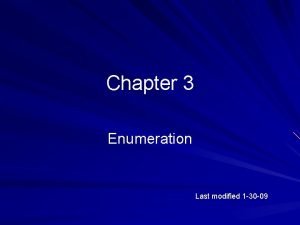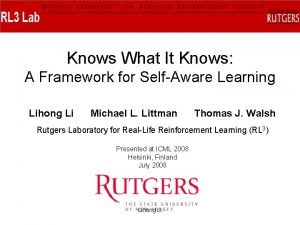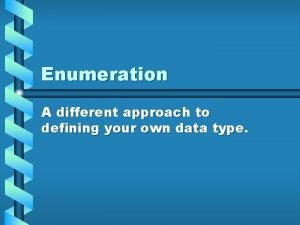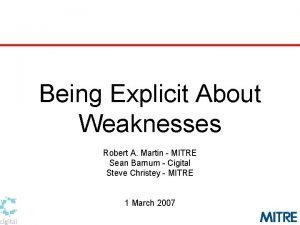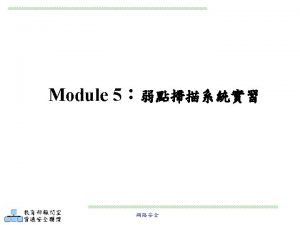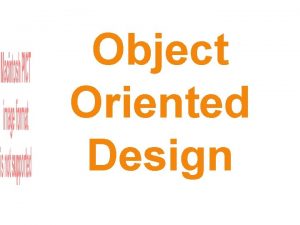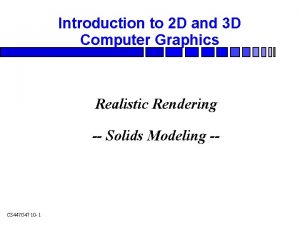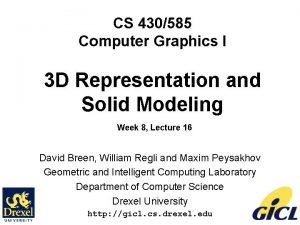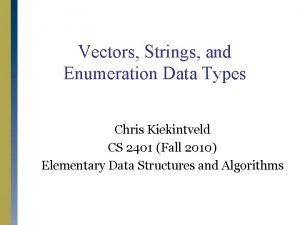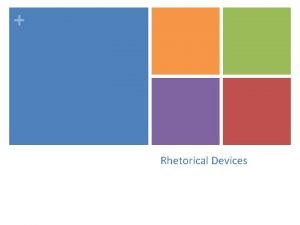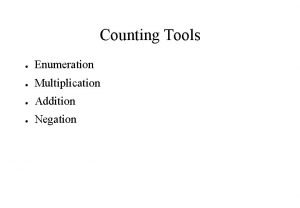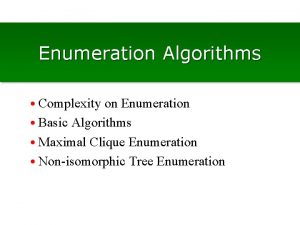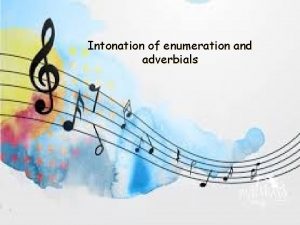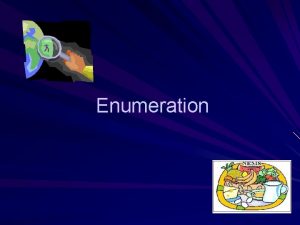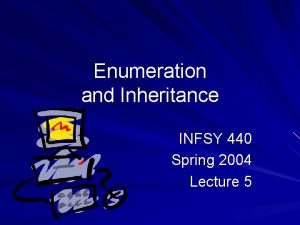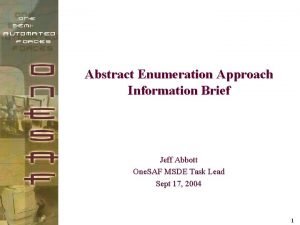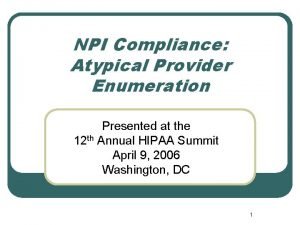Enumeration LECTURE 17 Enumeration An enumeration is a












![static void Main(string[] args) { Program p = new Program(); p. Get. Enum(); } static void Main(string[] args) { Program p = new Program(); p. Get. Enum(); }](https://slidetodoc.com/presentation_image_h/0aa40c82fc0ae30925343aa8685a2df0/image-13.jpg)

- Slides: 14

Enumeration LECTURE #17

Enumeration An enumeration is a set of named integer constants. An enumerated type is declared using the enum keyword. C# enumerations are value data type. In other words, enumeration contains its own values and cannot inherit or cannot pass inheritance.

Declaring enum Variable The general syntax for declaring an enumeration is: enum <enum_name> { enumeration list }; Where, The enum_name specifies the enumeration type name. The enumeration list is a comma-separated list of identifiers.

Declaring enum Variable Each of the symbols in the enumeration list stands for an integer value, one greater than the symbol that precedes it. By default, the value of the first enumeration symbol is 0. For example: enum Days { Sun, Mon, tue, Wed, thu, Fri, Sat }

Declaring enum Variable The following code shows an example of the declaration of a new enum type called Traffic. Light, which contains three members.

Declaring enum Variable Every enum type has an underlying integral type, which by default is int. § Each enum member is assigned a constant value of the underlying type. § The compiler assigns 0 to the first member, and assigns each subsequent member the value one more than the previous member. For example, in the Traffic. Light type, the compiler assigns the int values 0, 1, and 2 to members Green, Yellow, and Red, respectively

Declaring enum Variable In the output of the following code, you can see the underlying member values by casting them to type int Output Green, 0 Yellow, 1 Red, 2

Initialize an Enumeration You can specify the value of one or more of the symbols by using an initializer. Do this by following the symbol with an equal sign and an integer value. Symbols that appear after initializers are assigned values greater than the previous initialization value.

Use Enumerations are very useful when your program requires one or more specialized symbols. For example, imagine that you are writing a program that controls a conveyor belt in a factory. You might create a method called Conveyor( )that accepts the following commands as parameters: start, stop, forward, and reverse. Instead of passing Conveyor( )integers, such as 1 for start, 2 for stop, and so on, which is error-prone, you can create an enumeration that assigns words to these values.

using System; class Conveyor. Control { public enum Action { Start, Stop, Forward, Reverse }; public void Conveyor(Action com) { switch(com) { case Action. Start: Console. Write. Line("Starting conveyor. "); break; case Action. Stop: Console. Write. Line("Stopping conveyor. "); break; case Action. Forward: Console. Write. Line("Moving forward. "); break; case Action. Reverse: Console. Write. Line("Moving backward. "); break; } } }

class Conveyor. Demo { static void Main() { Conveyor. Control c = new Conveyor. Control(); c. Conveyor(Conveyor. Control. Action. Start); c. Conveyor(Conveyor. Control. Action. Forward); c. Conveyor(Conveyor. Control. Action. Reverse); c. Conveyor(Conveyor. Control. Action. Stop); } } The output from the program is shown here: Starting conveyor. Moving forward. Moving backward. Stopping conveyor.

class Program { enum Volume { high=1, low, Medium } public void Get. Enum() { Console. Write. Line("Select Volume: "); Console. Write. Line( "1. High"); Console. Write. Line("2. Low"); Console. Write. Line("3. Medium"); int i; i=Convert. To. Int 32(Console. Read. Line()); Volume my. Volume= (Volume)i; switch (my. Volume) { case Volume. high: Console. Write. Line("The volume has been turned up. "); break; case Volume. Medium: Console. Write. Line("The volume is in the middle. "); break; case Volume. low: Console. Write. Line("The volume has been turned down. "); break; }
![static void Mainstring args Program p new Program p Get Enum static void Main(string[] args) { Program p = new Program(); p. Get. Enum(); }](https://slidetodoc.com/presentation_image_h/0aa40c82fc0ae30925343aa8685a2df0/image-13.jpg)
static void Main(string[] args) { Program p = new Program(); p. Get. Enum(); } } }

End of Lecture 17
 01:640:244 lecture notes - lecture 15: plat, idah, farad
01:640:244 lecture notes - lecture 15: plat, idah, farad Port 135 enumeration
Port 135 enumeration Kwik algorithm
Kwik algorithm What is enumeration text type
What is enumeration text type Telnet enumeration
Telnet enumeration Mitre cwe
Mitre cwe Adieu veau vache cochon couvée figure de style
Adieu veau vache cochon couvée figure de style Inference by enumeration in artificial intelligence
Inference by enumeration in artificial intelligence Common configuration enumeration
Common configuration enumeration Uml for game design
Uml for game design Spatial occupancy enumeration
Spatial occupancy enumeration Spatial occupancy enumeration in cad
Spatial occupancy enumeration in cad Example of enumeration text
Example of enumeration text Rhetorical devices in art
Rhetorical devices in art Bufsiz
Bufsiz

